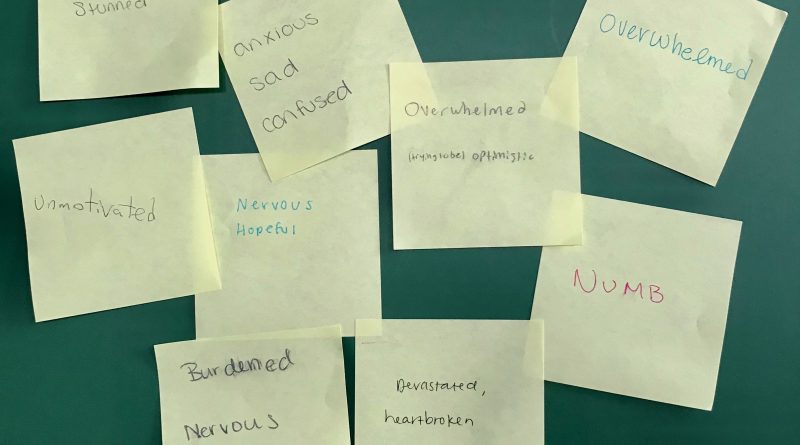Just Be: Mindfulness in the Classroom amidst an Anxious World
by Dana Grossman Leeman, Provost Faculty Fellow for Online Education at Simmons
Image: How our students were feeling as they left. Image Credit: students in the education department & Deborah Donahue-Keegan
The world we live in is full of noise and stimulation and the news is full of alarm and fear that is anxiety provoking. There are few respites from the realities of climate change, coronavirus, the labile stock market, cancellations of social events and public gatherings, and the quiet streets and empty store shelves. We all come into the classroom – whether virtual or face-to-face – in heightened emotional and neurochemical states, which makes it difficult if not impossible to be emotionally and cognitively present.
Mindfulness is the practice of being in the moment and noticing the moment with intention and without judgment of self or others. It is an evidence-based approach to self-care and supports the mental, physical, and emotional health of those who practice it. This has been well documented in medicine and psychiatry. In an academic setting, a few minutes of mindfulness can ground both teacher and student and prepare them for the work of learning.
Mindfulness practice is a wonderful way to start any class – be it large lecture, lab, or discussion-based seminar. Beginning with breathing and stillness allows everyone present to be – not to do, perform, or execute to any proscribed expectations, but simply to notice, and breathe. In his book, The Way of Mindful Education: Cultivating Well-Being in Teachers and Students, Daniel Rechtschaffen (2014) argues that creating a mindful approach to education help teach students to “notice and learn to manage the wild chatter in our own minds. Calming the mind, though not an easy job, is far more doable than getting the world to stop around us” (p. 44). Mindfulness practice done regularly will begin to train your students’ brains to respond with greater calm and sense of choice “instead of in a default manner, which often is a knee jerk reptilian reaction” (p. 33). In crises, this approach is of collective benefit.
Examples of mindfulness exercises:
Inviting stillness. This need not exceed a few minutes of class time. Invite your students to sit in their chairs wherever they are- online or face-to-face, and ask them to inhale through their noses and exhale through their mouths. Ask them to notice what thoughts they begin to have and what feelings they may be aware of in their bodies. Invite them to sit, breathe, and be still. They need not do anything else. You can also suggest that they quiet their minds with a mantra – which can be a line from a song, poem, or guided meditation. Thinking “I am here” while one is breathing can be enough to quiet a busy mind.
After a few minutes, you can ask the following questions and remind students that there are no wrong or right answers.
- What did you notice as you practiced being still?
- How “here” are you, or not?
- What can the group do to help you be more “here” with us?
Three Minutes of Thinking. Begin with two minutes of guided breathing – always inhale through the nose and exhale through the mouth. After a few minutes of breath, ask students to empty their minds by making a list of everything that is on their minds. Then, ask them to count the items on their list and then group them into ‘past’, ‘present’ and ‘future’. Ask students what they learned from their lists. The most common response is related to the number of items on their list and how many are related to the past or future. This helps you guide them back to the present, and maybe you as well.
Reference: Rechtshaffen, D. (2014). The way of mindful education: Cultivating well-being in teachers and students. New York/London: W.W. Norton & Company.
See Also



